Case Study: Occupational Health and Safety in Alberta Manufacturing
VerifiedAdded on 2019/10/31
|5
|1328
|270
Case Study
AI Summary
This case study analyzes a workplace accident in a manufacturing company in Alberta, focusing on the perspectives of a human resource professional. The assignment details the steps involved in managing the situation, considering employee workload and compensation, referencing sections 24, 25, and 42 of the Workers Compensation Act of Alberta. It explains the purpose of the act, outlining eligibility for compensation, employer and employee responsibilities during accidents, and the relevant steps to be taken, including emergency medical aid and risk assessment. The study also discusses direct and indirect costs associated with workplace accidents, providing a comprehensive overview of the incident and its management.
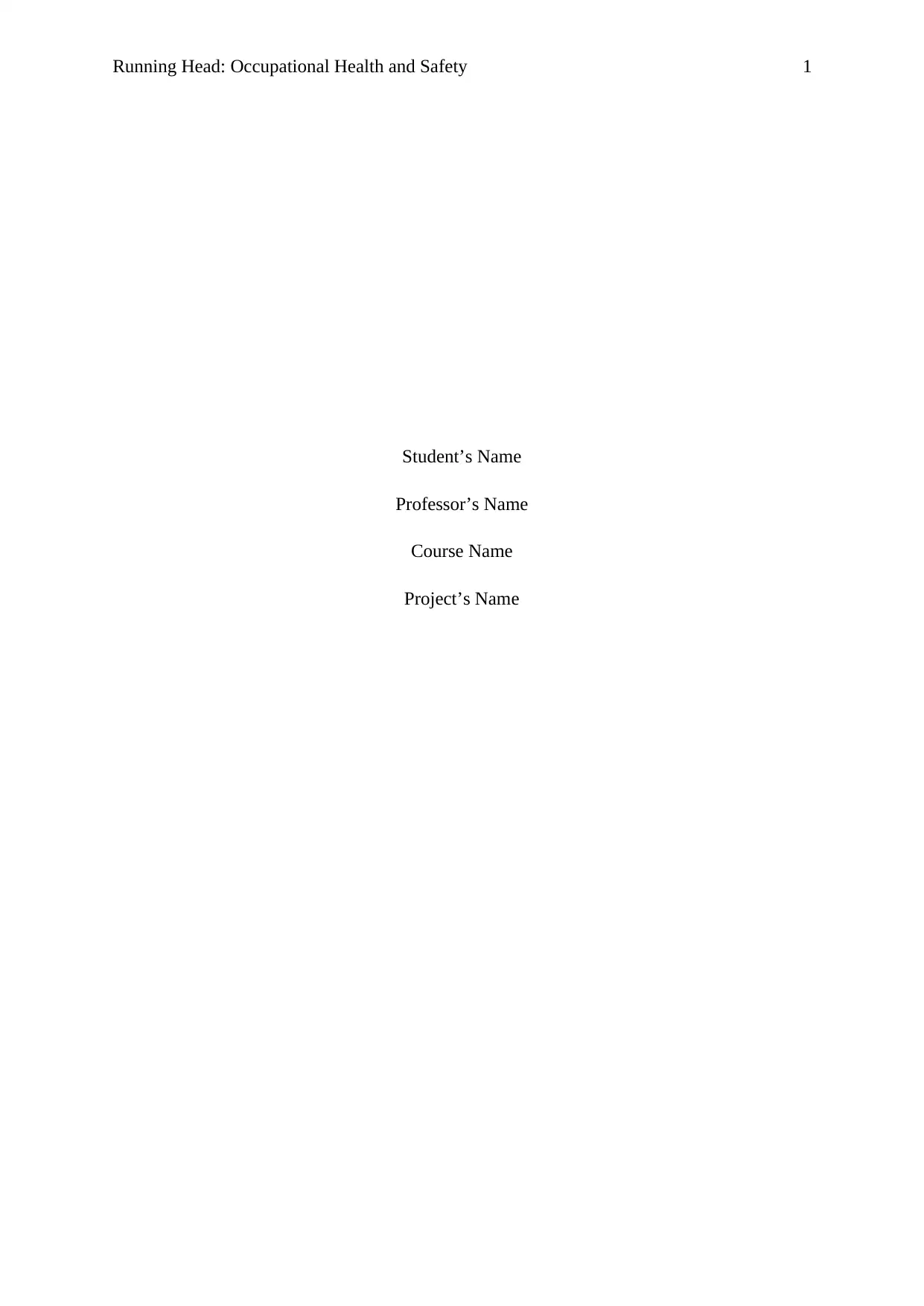
Running Head: Occupational Health and Safety 1
Student’s Name
Professor’s Name
Course Name
Project’s Name
Student’s Name
Professor’s Name
Course Name
Project’s Name
Paraphrase This Document
Need a fresh take? Get an instant paraphrase of this document with our AI Paraphraser
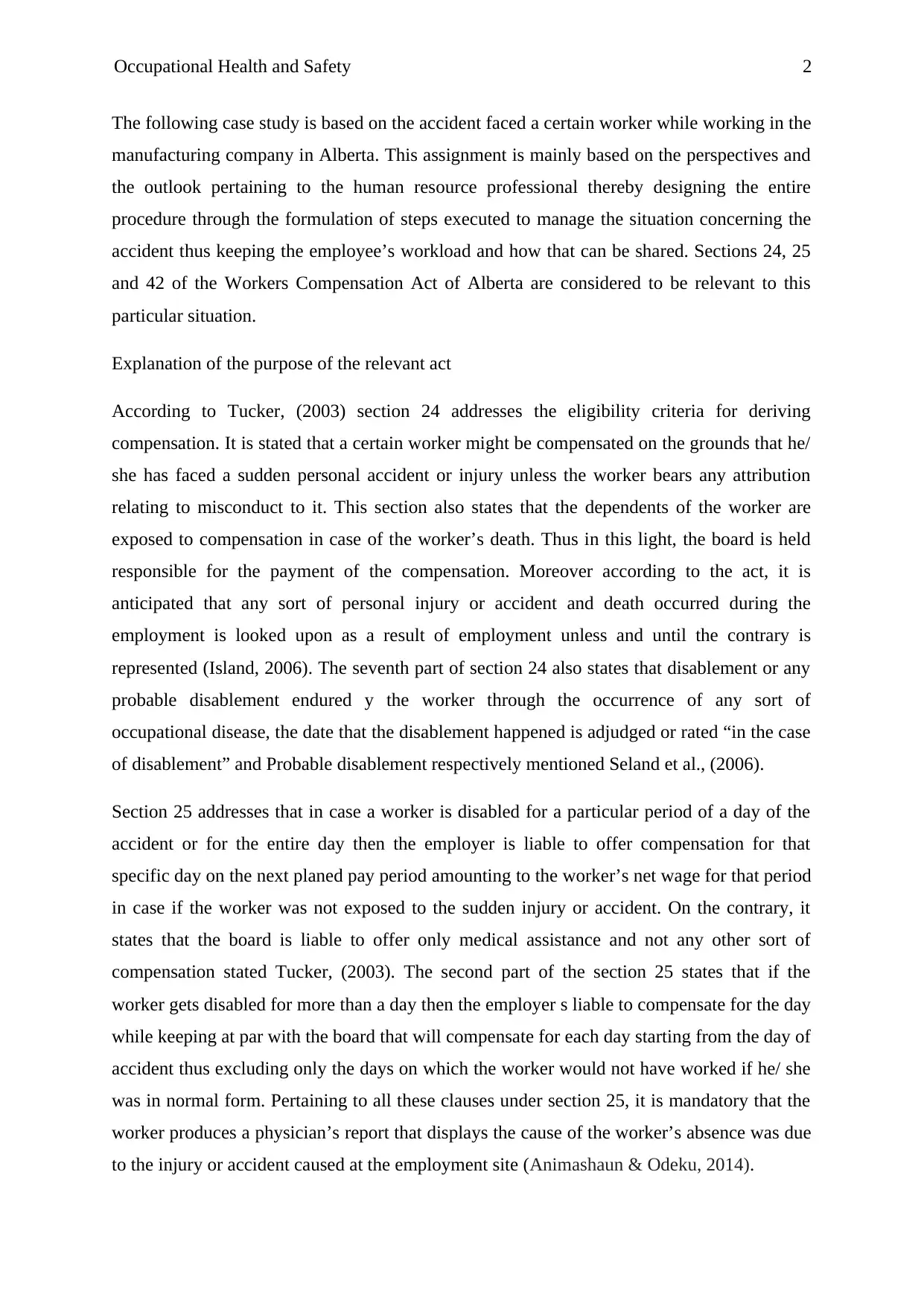
Occupational Health and Safety 2
The following case study is based on the accident faced a certain worker while working in the
manufacturing company in Alberta. This assignment is mainly based on the perspectives and
the outlook pertaining to the human resource professional thereby designing the entire
procedure through the formulation of steps executed to manage the situation concerning the
accident thus keeping the employee’s workload and how that can be shared. Sections 24, 25
and 42 of the Workers Compensation Act of Alberta are considered to be relevant to this
particular situation.
Explanation of the purpose of the relevant act
According to Tucker, (2003) section 24 addresses the eligibility criteria for deriving
compensation. It is stated that a certain worker might be compensated on the grounds that he/
she has faced a sudden personal accident or injury unless the worker bears any attribution
relating to misconduct to it. This section also states that the dependents of the worker are
exposed to compensation in case of the worker’s death. Thus in this light, the board is held
responsible for the payment of the compensation. Moreover according to the act, it is
anticipated that any sort of personal injury or accident and death occurred during the
employment is looked upon as a result of employment unless and until the contrary is
represented (Island, 2006). The seventh part of section 24 also states that disablement or any
probable disablement endured y the worker through the occurrence of any sort of
occupational disease, the date that the disablement happened is adjudged or rated “in the case
of disablement” and Probable disablement respectively mentioned Seland et al., (2006).
Section 25 addresses that in case a worker is disabled for a particular period of a day of the
accident or for the entire day then the employer is liable to offer compensation for that
specific day on the next planed pay period amounting to the worker’s net wage for that period
in case if the worker was not exposed to the sudden injury or accident. On the contrary, it
states that the board is liable to offer only medical assistance and not any other sort of
compensation stated Tucker, (2003). The second part of the section 25 states that if the
worker gets disabled for more than a day then the employer s liable to compensate for the day
while keeping at par with the board that will compensate for each day starting from the day of
accident thus excluding only the days on which the worker would not have worked if he/ she
was in normal form. Pertaining to all these clauses under section 25, it is mandatory that the
worker produces a physician’s report that displays the cause of the worker’s absence was due
to the injury or accident caused at the employment site (Animashaun & Odeku, 2014).
The following case study is based on the accident faced a certain worker while working in the
manufacturing company in Alberta. This assignment is mainly based on the perspectives and
the outlook pertaining to the human resource professional thereby designing the entire
procedure through the formulation of steps executed to manage the situation concerning the
accident thus keeping the employee’s workload and how that can be shared. Sections 24, 25
and 42 of the Workers Compensation Act of Alberta are considered to be relevant to this
particular situation.
Explanation of the purpose of the relevant act
According to Tucker, (2003) section 24 addresses the eligibility criteria for deriving
compensation. It is stated that a certain worker might be compensated on the grounds that he/
she has faced a sudden personal accident or injury unless the worker bears any attribution
relating to misconduct to it. This section also states that the dependents of the worker are
exposed to compensation in case of the worker’s death. Thus in this light, the board is held
responsible for the payment of the compensation. Moreover according to the act, it is
anticipated that any sort of personal injury or accident and death occurred during the
employment is looked upon as a result of employment unless and until the contrary is
represented (Island, 2006). The seventh part of section 24 also states that disablement or any
probable disablement endured y the worker through the occurrence of any sort of
occupational disease, the date that the disablement happened is adjudged or rated “in the case
of disablement” and Probable disablement respectively mentioned Seland et al., (2006).
Section 25 addresses that in case a worker is disabled for a particular period of a day of the
accident or for the entire day then the employer is liable to offer compensation for that
specific day on the next planed pay period amounting to the worker’s net wage for that period
in case if the worker was not exposed to the sudden injury or accident. On the contrary, it
states that the board is liable to offer only medical assistance and not any other sort of
compensation stated Tucker, (2003). The second part of the section 25 states that if the
worker gets disabled for more than a day then the employer s liable to compensate for the day
while keeping at par with the board that will compensate for each day starting from the day of
accident thus excluding only the days on which the worker would not have worked if he/ she
was in normal form. Pertaining to all these clauses under section 25, it is mandatory that the
worker produces a physician’s report that displays the cause of the worker’s absence was due
to the injury or accident caused at the employment site (Animashaun & Odeku, 2014).
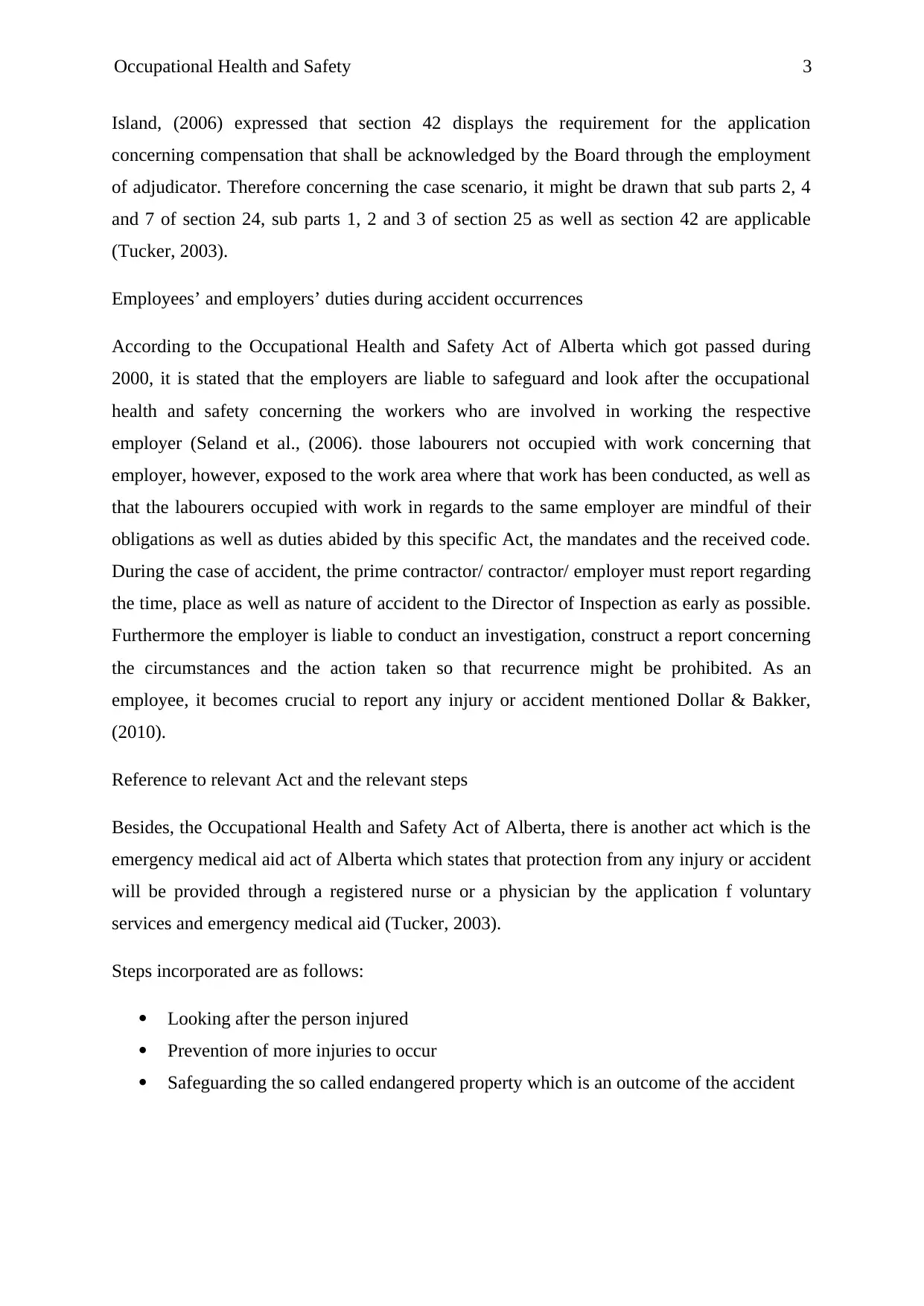
Occupational Health and Safety 3
Island, (2006) expressed that section 42 displays the requirement for the application
concerning compensation that shall be acknowledged by the Board through the employment
of adjudicator. Therefore concerning the case scenario, it might be drawn that sub parts 2, 4
and 7 of section 24, sub parts 1, 2 and 3 of section 25 as well as section 42 are applicable
(Tucker, 2003).
Employees’ and employers’ duties during accident occurrences
According to the Occupational Health and Safety Act of Alberta which got passed during
2000, it is stated that the employers are liable to safeguard and look after the occupational
health and safety concerning the workers who are involved in working the respective
employer (Seland et al., (2006). those labourers not occupied with work concerning that
employer, however, exposed to the work area where that work has been conducted, as well as
that the labourers occupied with work in regards to the same employer are mindful of their
obligations as well as duties abided by this specific Act, the mandates and the received code.
During the case of accident, the prime contractor/ contractor/ employer must report regarding
the time, place as well as nature of accident to the Director of Inspection as early as possible.
Furthermore the employer is liable to conduct an investigation, construct a report concerning
the circumstances and the action taken so that recurrence might be prohibited. As an
employee, it becomes crucial to report any injury or accident mentioned Dollar & Bakker,
(2010).
Reference to relevant Act and the relevant steps
Besides, the Occupational Health and Safety Act of Alberta, there is another act which is the
emergency medical aid act of Alberta which states that protection from any injury or accident
will be provided through a registered nurse or a physician by the application f voluntary
services and emergency medical aid (Tucker, 2003).
Steps incorporated are as follows:
Looking after the person injured
Prevention of more injuries to occur
Safeguarding the so called endangered property which is an outcome of the accident
Island, (2006) expressed that section 42 displays the requirement for the application
concerning compensation that shall be acknowledged by the Board through the employment
of adjudicator. Therefore concerning the case scenario, it might be drawn that sub parts 2, 4
and 7 of section 24, sub parts 1, 2 and 3 of section 25 as well as section 42 are applicable
(Tucker, 2003).
Employees’ and employers’ duties during accident occurrences
According to the Occupational Health and Safety Act of Alberta which got passed during
2000, it is stated that the employers are liable to safeguard and look after the occupational
health and safety concerning the workers who are involved in working the respective
employer (Seland et al., (2006). those labourers not occupied with work concerning that
employer, however, exposed to the work area where that work has been conducted, as well as
that the labourers occupied with work in regards to the same employer are mindful of their
obligations as well as duties abided by this specific Act, the mandates and the received code.
During the case of accident, the prime contractor/ contractor/ employer must report regarding
the time, place as well as nature of accident to the Director of Inspection as early as possible.
Furthermore the employer is liable to conduct an investigation, construct a report concerning
the circumstances and the action taken so that recurrence might be prohibited. As an
employee, it becomes crucial to report any injury or accident mentioned Dollar & Bakker,
(2010).
Reference to relevant Act and the relevant steps
Besides, the Occupational Health and Safety Act of Alberta, there is another act which is the
emergency medical aid act of Alberta which states that protection from any injury or accident
will be provided through a registered nurse or a physician by the application f voluntary
services and emergency medical aid (Tucker, 2003).
Steps incorporated are as follows:
Looking after the person injured
Prevention of more injuries to occur
Safeguarding the so called endangered property which is an outcome of the accident
⊘ This is a preview!⊘
Do you want full access?
Subscribe today to unlock all pages.

Trusted by 1+ million students worldwide
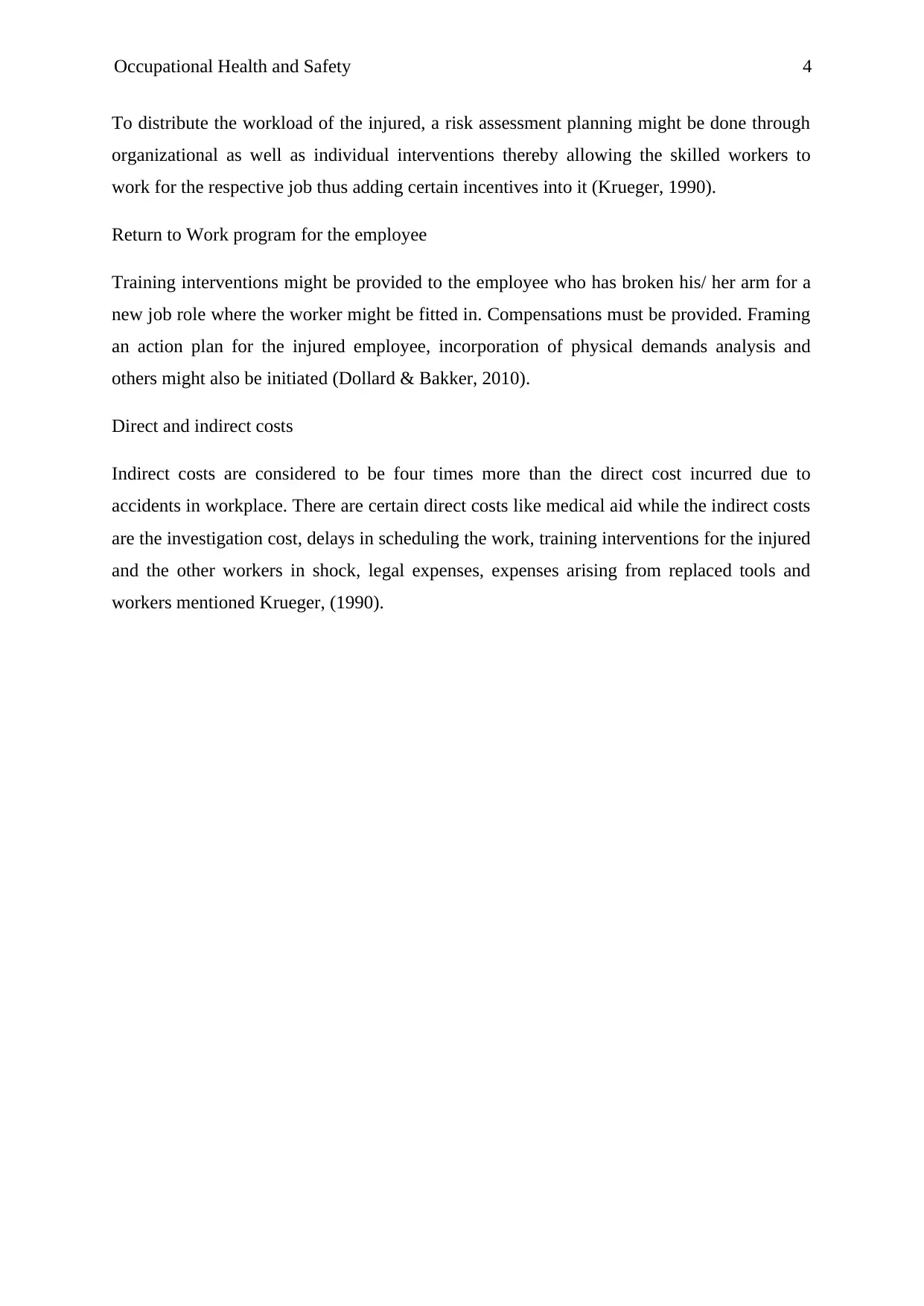
Occupational Health and Safety 4
To distribute the workload of the injured, a risk assessment planning might be done through
organizational as well as individual interventions thereby allowing the skilled workers to
work for the respective job thus adding certain incentives into it (Krueger, 1990).
Return to Work program for the employee
Training interventions might be provided to the employee who has broken his/ her arm for a
new job role where the worker might be fitted in. Compensations must be provided. Framing
an action plan for the injured employee, incorporation of physical demands analysis and
others might also be initiated (Dollard & Bakker, 2010).
Direct and indirect costs
Indirect costs are considered to be four times more than the direct cost incurred due to
accidents in workplace. There are certain direct costs like medical aid while the indirect costs
are the investigation cost, delays in scheduling the work, training interventions for the injured
and the other workers in shock, legal expenses, expenses arising from replaced tools and
workers mentioned Krueger, (1990).
To distribute the workload of the injured, a risk assessment planning might be done through
organizational as well as individual interventions thereby allowing the skilled workers to
work for the respective job thus adding certain incentives into it (Krueger, 1990).
Return to Work program for the employee
Training interventions might be provided to the employee who has broken his/ her arm for a
new job role where the worker might be fitted in. Compensations must be provided. Framing
an action plan for the injured employee, incorporation of physical demands analysis and
others might also be initiated (Dollard & Bakker, 2010).
Direct and indirect costs
Indirect costs are considered to be four times more than the direct cost incurred due to
accidents in workplace. There are certain direct costs like medical aid while the indirect costs
are the investigation cost, delays in scheduling the work, training interventions for the injured
and the other workers in shock, legal expenses, expenses arising from replaced tools and
workers mentioned Krueger, (1990).
Paraphrase This Document
Need a fresh take? Get an instant paraphrase of this document with our AI Paraphraser
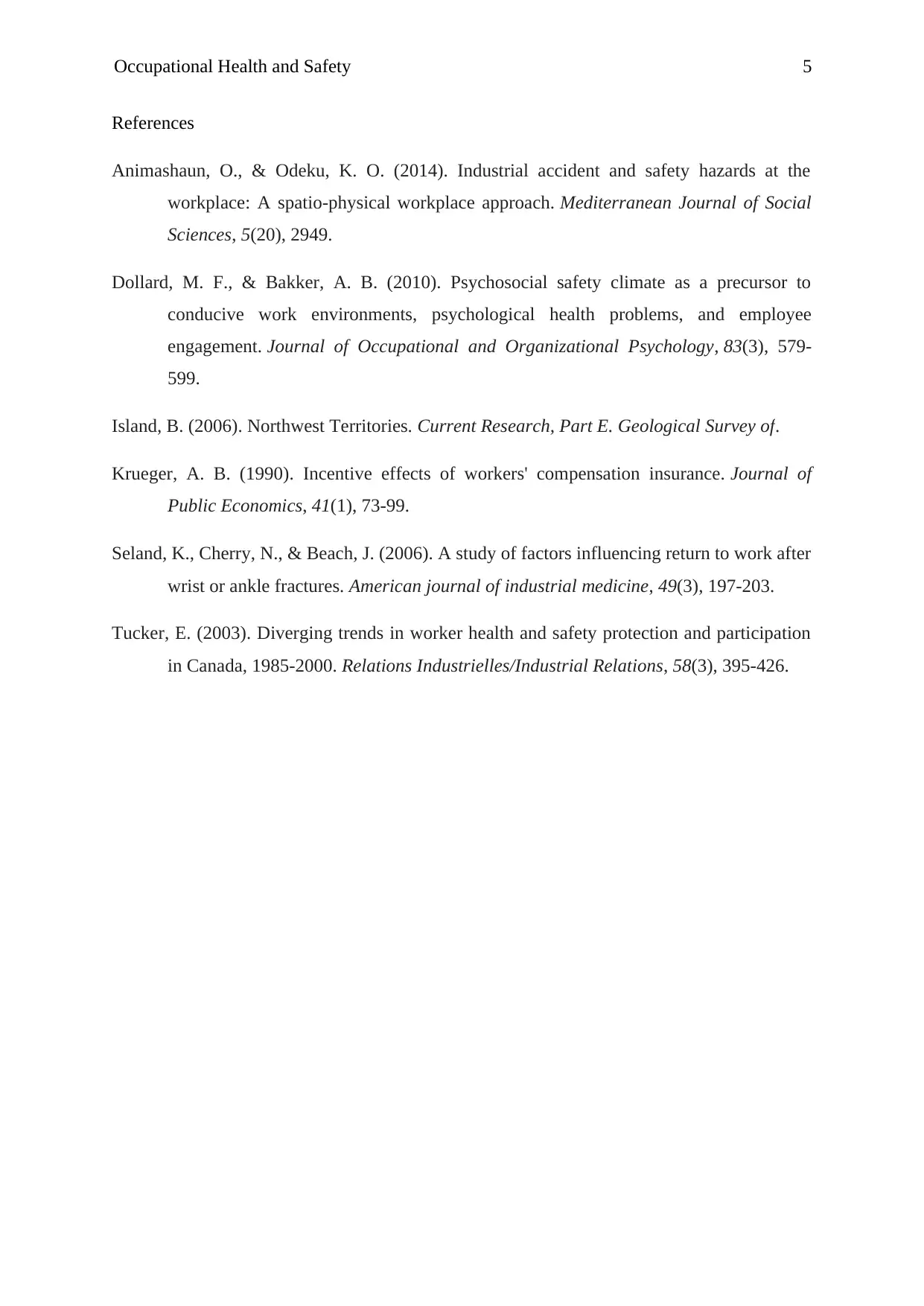
Occupational Health and Safety 5
References
Animashaun, O., & Odeku, K. O. (2014). Industrial accident and safety hazards at the
workplace: A spatio-physical workplace approach. Mediterranean Journal of Social
Sciences, 5(20), 2949.
Dollard, M. F., & Bakker, A. B. (2010). Psychosocial safety climate as a precursor to
conducive work environments, psychological health problems, and employee
engagement. Journal of Occupational and Organizational Psychology, 83(3), 579-
599.
Island, B. (2006). Northwest Territories. Current Research, Part E. Geological Survey of.
Krueger, A. B. (1990). Incentive effects of workers' compensation insurance. Journal of
Public Economics, 41(1), 73-99.
Seland, K., Cherry, N., & Beach, J. (2006). A study of factors influencing return to work after
wrist or ankle fractures. American journal of industrial medicine, 49(3), 197-203.
Tucker, E. (2003). Diverging trends in worker health and safety protection and participation
in Canada, 1985-2000. Relations Industrielles/Industrial Relations, 58(3), 395-426.
References
Animashaun, O., & Odeku, K. O. (2014). Industrial accident and safety hazards at the
workplace: A spatio-physical workplace approach. Mediterranean Journal of Social
Sciences, 5(20), 2949.
Dollard, M. F., & Bakker, A. B. (2010). Psychosocial safety climate as a precursor to
conducive work environments, psychological health problems, and employee
engagement. Journal of Occupational and Organizational Psychology, 83(3), 579-
599.
Island, B. (2006). Northwest Territories. Current Research, Part E. Geological Survey of.
Krueger, A. B. (1990). Incentive effects of workers' compensation insurance. Journal of
Public Economics, 41(1), 73-99.
Seland, K., Cherry, N., & Beach, J. (2006). A study of factors influencing return to work after
wrist or ankle fractures. American journal of industrial medicine, 49(3), 197-203.
Tucker, E. (2003). Diverging trends in worker health and safety protection and participation
in Canada, 1985-2000. Relations Industrielles/Industrial Relations, 58(3), 395-426.
1 out of 5
Your All-in-One AI-Powered Toolkit for Academic Success.
+13062052269
info@desklib.com
Available 24*7 on WhatsApp / Email
![[object Object]](/_next/static/media/star-bottom.7253800d.svg)
Unlock your academic potential
Copyright © 2020–2025 A2Z Services. All Rights Reserved. Developed and managed by ZUCOL.

